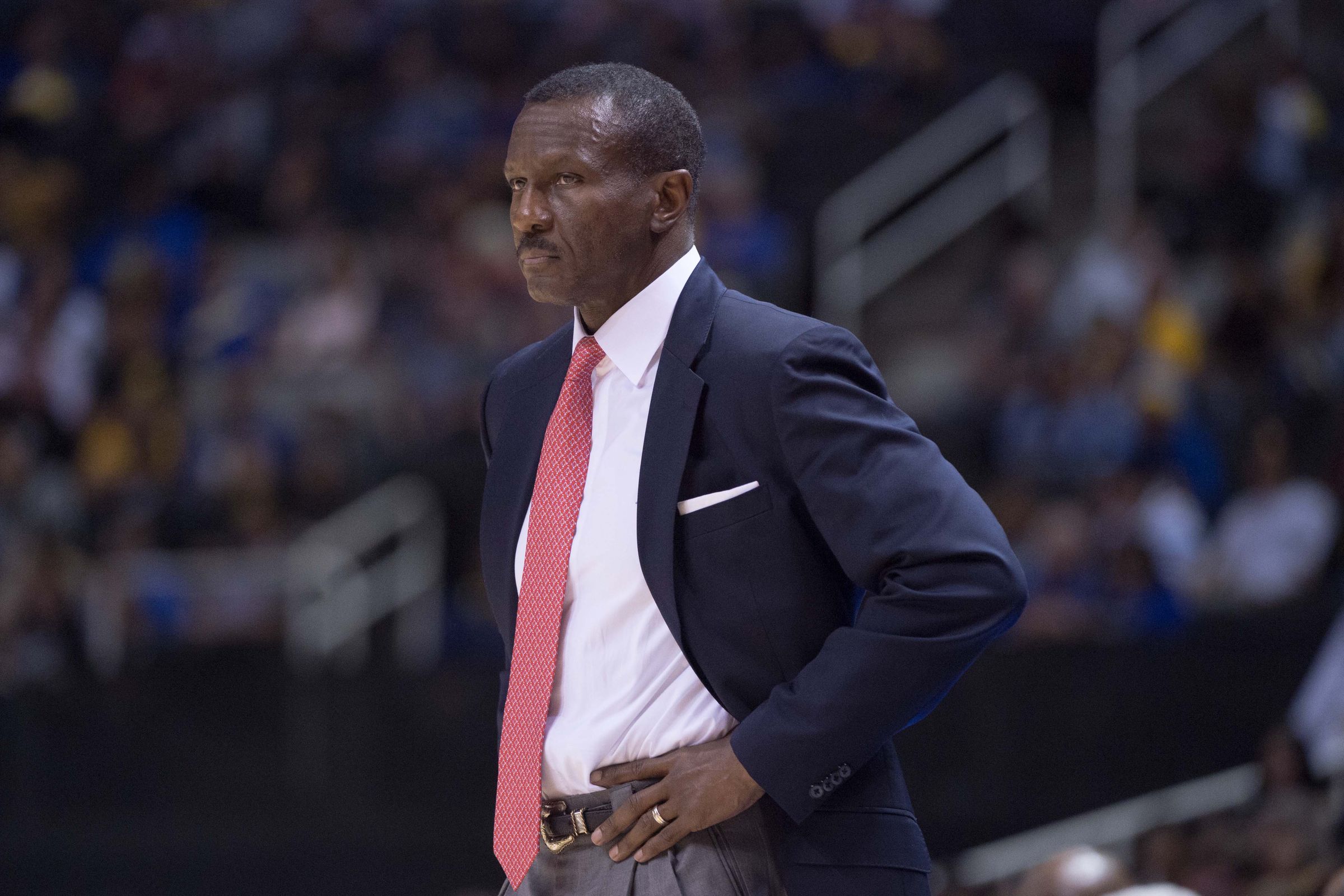What if there’s no way to explain things like deja vu and acid rain?
The endings of the Toronto Raptors’ last three games have been tough to swallow. They’ve all been losses on the road to west coast teams, generally forgivable scenarios, but they’ve lost by six, five, and four points. Three games where a possession or two could have swung the outcome, where slightly better execution could have been the difference between an 0-3 start to the trip or 1-2, 2-1, or even 3-0. Playing close games in tough situations is valiant. Coughing away those opportunities is not.
Narrow losses provide for plenty of opportunity to nitpick and get lost in what-ifs. The Raptors had a tough call go against them late against the Kings, the team’s decision-making was curious against the Warriors, and their execution late against Utah was found wanting.
There was an unfortunate commonality between the way the Warriors and Jazz games played out late – the Raptors were without a timeout for key offensive possessions. In both cases, the Raptors were forced to burn their final timeout early because of an inability to inbound the ball coming out of a timeout. Two fourth quarters, two double-timeout scenarios, neither of which led to points on the eventual ATO play. A closer look is warranted.
108-103 Warriors, 1:28 to play
Following a Steph Curry bucket (the one he traveled on), the Raptors call a full timeout. Down five but with plenty of time, head coach Dwane Casey doesn’t make a substitution but simply wants to advance the ball and set up a high-quality look. Here’s what happens out of the full timeout:
[gfy]AllShimmeringAxolotl [/gfy]
The play starts off with DeMar DeRozan running toward the inbounder (DeMarre Carroll) over a Luis Scola screen. DeRozan has a chance to flare to the top for the ball, but he also sees a ton of space in the short corner if he continues to curl.
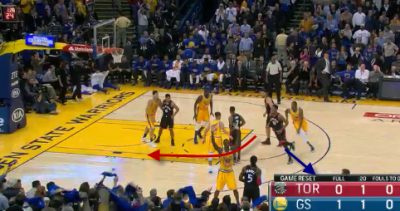
The inbound is well-guarded, but DeRozan doesn’t look to the short corner. Instead, he continues on whatever path has originally been drawn up. The other three Raptors look to create confusion at the free-throw line, where it’s unclear who is screening for whom and who may pop out.
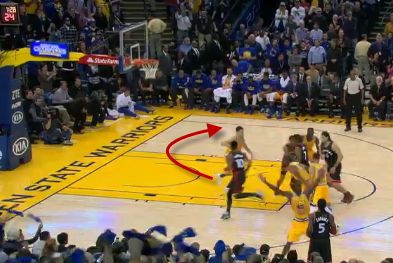
Because DeRozan didn’t go short-corner, the defense shifts to prevent Carroll from inbounding up top, where Cory Joseph breaks free. It becomes clear why DeRozan continued his slow looping jog, as Scola breaks into the open space DeRozan would have been occupying
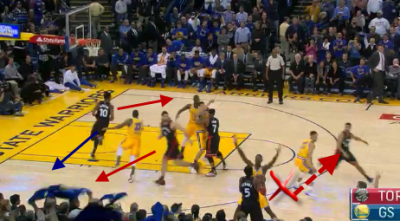
Scola winds up open enough to thread a pass to, and with the defense still trying to prevent a pass up top, Carroll had the space. Thinking it too great a risk and with the referee counting down, Carroll calls for the team’s final 20-second timeout.
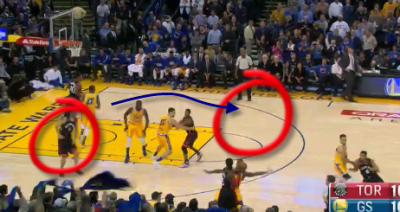
It’s tough to judge that final image, because the play isn’t just about inbounding the ball. Had DeRozan cut aggressively back up top, there was a ton of space. That would have been a difficult pass for Carroll over an outstretched defender and may have put DeRozan too far away from where the play call dictated he start, but he could have popped up late as an additional option. Really, the pass could have gone to Scola, burning a few seconds as the team reset up top rather than a timeout.
Perhaps more frustrating than the inability to inbound is that after a second timeout, the Raptors inbounded the ball to have DeRozan attack Draymond Green, committing a turnover. That’s a lot of time and two valuable timeouts spent on getting your top scorer the ball on his usual curl that the Warriors seemed to know as coming (Curry shades off of Lowry to fill space until DeRozan’s man recovers over the screen).
[gfy]LightheartedShyKob[/gfy]
The Raptors would still manage to fight back within one point, and when Curry missed a six-footer with 25 seconds to go, the Raptors had a legitimate chance to win. Unfortunately, they didn’t have a timeout left to set anything up, and a rushed play led to a Lowry offensive foul.
91-87 Jazz, 0:23 to play
Following a Derrick Favors dunk, the Raptors call a 20-second timeout. Down four with the need to score on this possession, Casey opts not to make a substitution, leaving Scola in for Jonas Valanciunas as the center with the team’s de facto closing unit. The Jazz bring Rudy Gobert back into the game for Joe Ingles. Have a look at the ATO:
[gfy]GrouchySparklingFirecrest [/gfy]
Once again, DeRozan flares up top quickly. In this case, Carroll easily could have made the pass, but that’s not the play design and DeRozan carries on his way. The other three Raptors set up for a well-disguised screen for Joseph, who originally looks to be setting the first in a staggered double-screen for Lowry.
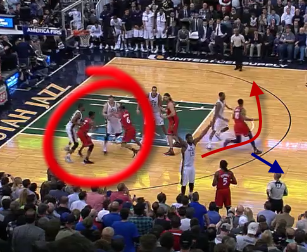
Instead of Joseph screening, he uses a Lowry screen to pop into the corner. He doesn’t get much separation and opts to cut deep into the corner rather than coming closer for an easier pass. That’s because some Scola-Lowry action appears to be coming and that space might be needed. DeRozan remains at the top of the arc as a safety valve.
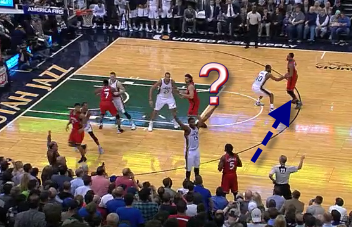
The apparent Scola-Lowry stalled action was a decoy, and Scola quickly pops away from Gobert to the top of the arc. Carroll has a great opportunity to find Scola here, and DeRozan would be nearby for a dribble hand-off early in the clock if that’s not the desired inbound outcome. In that event, Lowry and Joseph would be in the corners for a kickout off of a DeRozan drive.
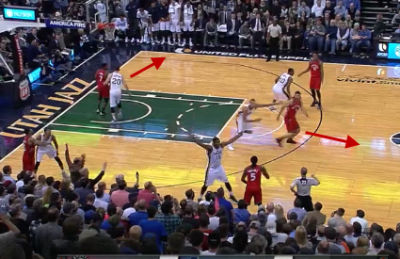
Instead, Scola breaks away from Carroll, readying to set a screen that would allow DeRozan to pop up top again for a pass. The benefit of this action instead of inbounding to DeRozan in the same place earlier is that DeRozan would be receiving the ball on the move, around a screen, possibly switched onto Gobert with shooters in the corners to prevent help.
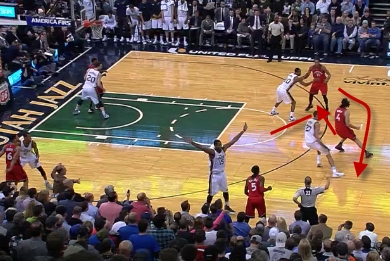
It’s a pretty good play design, but Gobert sniffs it out and jumps the cut, denying DeRozan the ball. Scola doesn’t have much of an option to play safety valve here – he could break toward Carroll, but he risks getting in DeRozan’s way, and Favors has the inbound angled off well to prevent a pass to the top of the key – and the Raptors have already taken their own point guards out of the play.
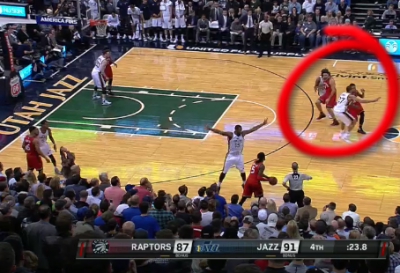
Carroll has to burn the team’s final 20-second timeout from there, and a decent play design (albeit one with really only a single option) is rendered ineffective in large part by the length and awareness of Gobert. Such is life against the Jazz. Using a final timeout with 23 seconds left is far more justifiable than 88 seconds the night prior, but having to kill back-to-back 20-second timeouts because of an inability to inbound isn’t the best use of key late-game assets.
Like with the Warriors situation, additional frustration comes from the fact that the Raptors ran a DeRozan one-on-one out of a second timeout, one that once again resulted in a turnover.
[gfy]InsecureGreedyAurochs[/gfy]
The Jazz would subsequently extend the lead to five, one the Raptors couldn’t surmount in 18 seconds without the benefit of timeouts to advance the ball.
Three tight games lost at the margins to start a road trip, two of them impacted by an inability to inbound the ball at key junctures. Any guesses as to what the team might work on in practice once they’re back home?

